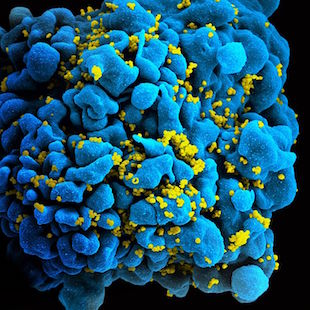CRISPR/Cas9 gene editing has shown remarkable therapeutic potential, including the ability to fightpathogens like HIV. But the same process that inactivates the deadly virus may also enable it to escape the treatment, according to research led byChen Liang of McGill University in Montreal, published today (April 7) in Cell Reports.
“It’s very nice work which offers important information related to development and use of CRISPR/Cas9 for suppressing viruses in this case, HIV infection,” neuroscientist Kamel Khalili of Temple University’s Lewis Katz School of Medicine in Philadelphia who was not part of the study told The Scientist. “Their data suggest targeting a single site within a viral gene can accelerate viral escape and emergence of mutant virus that remains resistant to initial targeting molecules.”
The findings essentially replicate those of another group, led by Atze Das of the Center for Infection and Immunity Amsterdam. The Das team’s findings appeared last month (February 16) in Molecular Therapy.
“We both demonstrated HIV-1 can be inhibited by the CRISPR/Cas system, and [that] the virus can escape,” Das, who was not involved in the new research, told The Scientist. He said the similarity of the studies was a coincidence.
A number of previous studies have demonstrated that CRISPR/Cas9 can be used to prevent HIV from replicating, but there wasn’t much evidence that the virus could escape that repression.
For the present study, Liang and colleagues used single guide RNAs (sgRNAs) and the Cas9 enzyme to target and snip out HIV-1 DNA from the genome of human T cells in vitro.
When Cas9 cuts the DNA, the cell repairs it using a process called nonhomologous end joining. This process is prone to errors, resulting in insertion and deletion mutations, or indels. By culturing cells with CRISPR-modified HIV, the researchers showed that these indels are lethal for the virus they reduce the number of infected cells, and produce fewer infectious viruses.
However, some of the mutations were minor enough that the virus was able to escape and infect other cells. When the researchers cloned and sequenced the DNA from the escaped virus, they expected to see mutations throughout the DNA. “But we found that the mutations were all clustered at one site where the Cas9 enzyme cleaves the viral DNA,” Liang told The Scientist. As a result, the sgRNA could no longer recognize the viral sequence, rendering it immune to future CRISPR attack.
The study provides “experimental evidence to show the existence of HIV viral escape for single guide RNA/Cas9,” neurovirologist Wenhui Hu of Temple University who was not involved in the work told The Scientist in an email, “although it was predicted and the proof of concept had been proposed or tested,” he added.
Liang’s team is now working on ways to address the problem. One method the authors suggest demonstrated by Hu’s team and other groups is to target the viral DNA using multiple guide RNAs, which increases the chances of disabling the virus.
Another approach would be to use an enzyme other than Cas9 to cleave the DNA. Cas9 works by cutting the gene at the same place where the guide RNA binds, and the cell introduces mutations at that site. By contrast, other enzymes, such as Cpf1, doesn’t cut both strands right at the RNA binding site. If the DNA were the text on a piece of paper, Cas9 cuts it right next to the words, whereas “Cpf1 cuts on the edges,” Liang explained.
It’s worth knowing the limitation of using CRISPR with an sgRNA, said Liang. “If you don’t know it and you use [the technique] in a patient, it will fail.”







